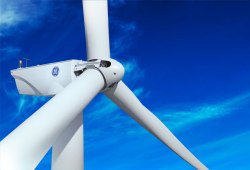
General ElectricA new GE wind turbine comes with battery included.
If you want to use solar power at night or wind power on calm days, you need batteries that can store energy after it’s produced. But why bother with two pieces of equipment when you could have one?
Engineers are now beginning to build batteries directly into wind and solar systems.
Combined renewable generation-storage systems are just starting to be deployed in the wind sector. From a report last month in Quartz:
[W]hat if every wind turbine became a node in an energy internet, communicating with the grid and each other to adjust electricity production while storing and releasing electricity as needed? That’s the idea behind General Electric’s new “brilliant” turbine, the first three of which the company said … will be installed at a Texas wind farm operated by Invenergy.
The 2.5-MW windmill is something of a technological leap in an industry where turbines have gotten bigger and bigger but not necessarily smarter. The turbine’s software captures tens of thousands of data points each second on wind and grid conditions and then adjusts production, storing electricity in an attached 50 kilowatt-hour sodium nickel chloride battery. If, say, a wind farm is generating too much electricity to [be] absorbed by the grid—not an uncommon occurrence in gusty west Texas—it can store the electricity in the battery. When the wind dies down, the electricity can be released from the battery and put back on the grid.
“This provides a path for lowering the cost of energy even more,” Keith Longtin, general manager of GE’s wind product line, told Quartz. “We think by being able to integrate the storage into the turbine and by being able to provide predictable power it’s going to minimize a lot of the balancing the grid has to do today.”
And the solar industry is trying to catch up. A team of University of Wisconsin researchers describes a new invention in the journal Advanced Materials. From a press release:
In a quest for a smaller, more self-sustaining solar power source, a UW-Madison electrical engineer has proposed a design for solar panels that can simultaneously generate power from sunlight and store power reserves for later, all within a single device. …
The final design allows for a standard-size solar cell that can simultaneously power a device and store energy for later use, creating a closed-loop system for small-scale applications of solar energy. “We can have some energy set aside locally, right in the panel, so that when you need it, you can get it,” says [engineer Hongrui] Jiang. …
Other such solar panels — referred to as photovoltaic self-charging cells — have been around for a while, but the ability to provide energy continuously, rain or shine, sets Jiang’s apart. …
Since the design scales up easily, says Jiang, microgrids — small scale power grids used to balance renewable power sources in energy-efficient buildings — would be another ideal application, since self-contained solar panels would limit the need for battery management and would allow engineers to design buildings that rely on the outside power grid even less than current systems.
And there are futuristic applications: picture lighting systems that can be installed in remote areas — without running expensive power lines. “You could have one solar panel installed that will store the energy the system might need through nights and cloudy days,” says Jiang.



